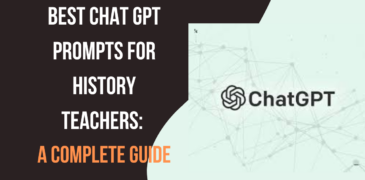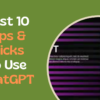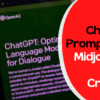Hello there, friends and fellow educators! If you’re like me, you are constantly on the hunt for new and innovative ways to make your history lessons more engaging and memorable for your students. This post is all about how to leverage cutting-edge AI technology to bring history alive in your classroom in ways you might not have imagined.
ChatGPT, developed by OpenAI, is an advanced language model that generates human-like text based on the prompts it’s given. It’s like having a personal assistant who can draft emails, write essays, answer questions and even more excitingly for us history educators, simulate historical dialogues and debates.
In this post, we will delve into a list of the best ChatGPT prompts for history teachers that can help transform your classroom into a vibrant, interactive learning environment. So, grab a cup of coffee and get comfortable, because we’re about to dive into the world of AI-enhanced history teaching!
Why Use ChatGPT in History Teaching?
Before we explore the prompts, let’s first address why you should consider using ChatGPT in your history classes.
- Interactive Learning: ChatGPT can simulate dialogues, debates, and interviews with historical figures, creating an immersive and interactive experience for your students.
- Better Understanding of Historical Contexts: Students can gain a better understanding of the thoughts, motivations, and situations of people in different eras through AI-generated responses based on historical data.
- Promoting Critical Thinking: It’s not just about feeding information. Engaging with ChatGPT can help students develop their critical thinking skills as they interpret and analyze the AI’s responses.
Now that we’ve covered the why, let’s move on to the what – the prompts!
Best ChatGPT Prompts for History Teachers
Simulating Dialogues with Historical Figures
This is one of the most engaging ways to use ChatGPT. Ask it to assume the role of a historical figure and then have your students engage in conversation with the “character”. Here are a few prompt ideas:
- “As Abraham Lincoln, describe your thoughts and feelings after signing the Emancipation Proclamation.”
- “Assume you’re Queen Elizabeth I. Explain your reasons for not marrying and your views on ruling England as a female monarch.”
- “If you were Mahatma Gandhi, describe the principles of Satyagraha and how you used it as a tool for achieving India’s independence.”
Describing Historical Events
Use ChatGPT to provide a detailed narrative of historical events. This could bring new perspectives and insights to these events.
- “Describe the events of D-Day from the perspective of a soldier landing on the beaches of Normandy.”
- “Tell the story of the Civil Rights Movement from the viewpoint of a civil rights activist in the 1960s.”
- “Narrate the events leading up to the fall of the Berlin Wall, as perceived by a citizen living in East Germany.”
Debates on Historical Topics
Prompts that stimulate a debate can provoke your students to think critically about different aspects of history.
- “Argue for and against the decision to drop atomic bombs on Hiroshima and Nagasaki in 1945.”
- “Discuss the benefits and drawbacks of the Industrial Revolution for the working class in England.”
- “Debate the impacts of Columbus’s voyages on the indigenous populations of the Americas.”
Hypothetical Situations
Another interesting way to use ChatGPT is to explore ‘what if’ scenarios. This encourages students to consider the possible outcomes if a historical event had turned out differently.
- “What if the American Revolution had not been successful? Discuss potential outcomes.”
- “Imagine if the Berlin Wall hadn’t fallen in 1989. What might Germany look like today?”
- “What might have happened if the Civil Rights Movement in the U.S. had not taken place?”
Remember, the goal of using these prompts isn’t to take the AI’s responses as factual or infallible. Instead, it’s a tool for generating discussion, sparking curiosity, and promoting critical thinking.
Also read:
How to Integrate ChatGPT Into Microsoft Word
How to Use ChatGPT on Android and iOS
How to Draw Graphs, Charts and Diagrams in ChatGPT
How to Save and Share ChatGPT Conversations
FAQs
How reliable is the information generated by ChatGPT?
While ChatGPT can generate impressive and human-like text, it is important to remember that it is an AI tool that is not capable of understanding or conscious thought. It generates responses based on patterns in the data it was trained on. Therefore, its output should not be considered as absolutely accurate or factual. It’s always necessary to fact-check and validate the information provided by the AI.
Can I use ChatGPT to grade my students’ assignments?
As of my knowledge cutoff in September 2021, ChatGPT is not designed to perform tasks like grading assignments. While it can help generate responses or provide information, it cannot evaluate the quality or correctness of a student’s work.
Can ChatGPT replace teachers in a classroom setting?
Absolutely not. ChatGPT is a tool designed to aid teaching, not replace teachers. It can offer assistance in generating creative content, answering queries, or facilitating interactive learning, but it lacks the personal connection, empathy, understanding, and adaptability that human teachers bring to a classroom.
How can I use ChatGPT to accommodate different learning styles in my classroom?
ChatGPT can be used in a variety of ways to suit different learning styles. For visual learners, you can use it to describe historical scenes or events in detail. For auditory learners, you can use it in debates or discussions. For kinesthetic learners, you can create interactive sessions where they can engage in role-plays or simulations with the AI.
What if a student asks ChatGPT a controversial or sensitive historical question?
If used properly, this can serve as an opportunity to engage students in thoughtful discussions and critical thinking. However, it’s crucial to remind students that the AI’s responses are based on patterns in the data it was trained on and should be considered as starting points for discussion rather than definitive answers.
Can I use ChatGPT to simulate a historical debate?
Absolutely! This is one of the most engaging ways to use ChatGPT. You can set it up to take on the roles of various historical figures, and then ask it to debate a particular historical event or decision. It’s a great tool for helping students to see different viewpoints and understand the complexities of history.
Is there a limit to the length of prompts or responses with ChatGPT?
Yes, there are limitations on the size of the model’s input and output. For the largest version of the model, the total number of input and output tokens (a token can be as short as one character or as long as one word) can’t exceed a certain limit (around 2048 tokens). This means extremely lengthy dialogues might need to be truncated or shortened.
Can I customize ChatGPT to better suit my teaching style or a particular lesson plan?
While you can’t modify the underlying model of ChatGPT, you can customize the way you use it by creating specific prompts that align with your teaching style or lesson objectives. The prompts can be tailored to simulate dialogues, describe events, debate historical topics, and more.
How can I handle situations where ChatGPT provides incorrect or misleading information?
Use these situations as learning opportunities. They can open discussions about information literacy, the reliability of AI, and the importance of fact-checking. Remember, the goal of using AI in education isn’t to provide a flawless source of information but to stimulate learning, curiosity, and critical thinking.
Can using ChatGPT help improve my students’ engagement in history lessons?
It certainly can! By providing interactive dialogues, fresh perspectives, and ‘what if’ scenarios, ChatGPT can make history lessons more engaging and memorable. It’s a great way to show students that history is not just about memorizing facts and dates, but also about understanding human motivations, experiences, and complex historical events.
Conclusion
So there you have it, dear friends, a complete guide to using ChatGPT as a unique tool in your history classroom. Just like any teaching tool, it’s not about replacing the teacher but enhancing what we already do so well – igniting the spark of curiosity and the love of learning in our students.
With ChatGPT, we can create a dynamic and interactive learning environment where history is not just about memorizing dates and facts, but about understanding the complexities of human experiences and events across time and space.
As we journey into this brave new world of AI in education, let’s not forget that technology is a tool that serves us, not the other way around. We are the architects of our classrooms, and it’s in our hands to shape how we use AI to enrich our teaching and our students’ learning.
And remember, the prompts listed here are just the beginning. Feel free to customize and expand upon them to better suit your teaching style and your students’ interests. Let your creativity guide you in this exciting journey of combining technology with teaching.
So, why not give these prompts a whirl in your next history class and see the magic happen? Don’t forget to share your experiences and ideas in the comment section below! As always, let’s learn from each other, inspire each other, and continue to transform the world, one classroom at a time!
As the Roman philosopher Seneca once said, “While we teach, we learn.” Happy teaching, happy learning, and until next time, my fellow educators!







